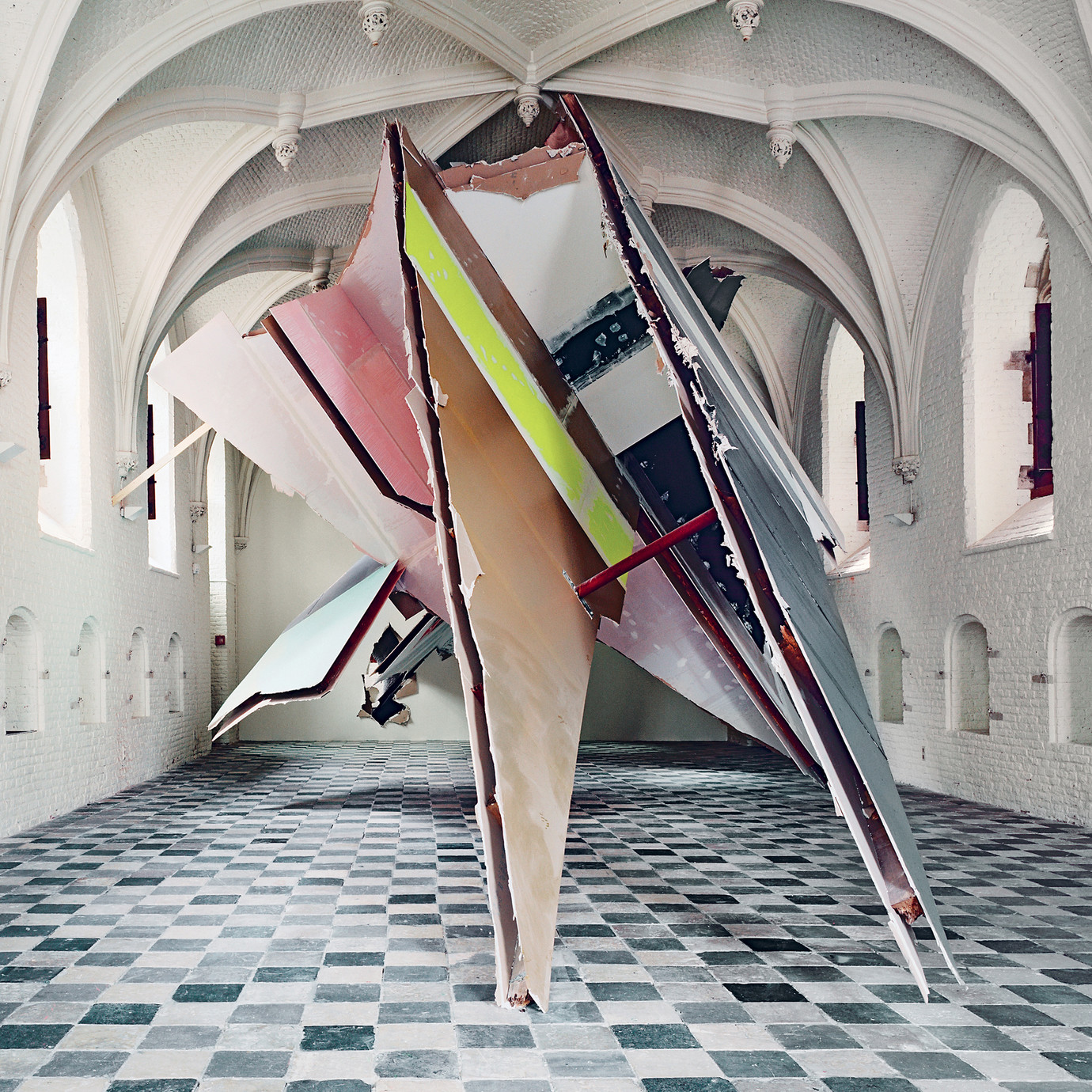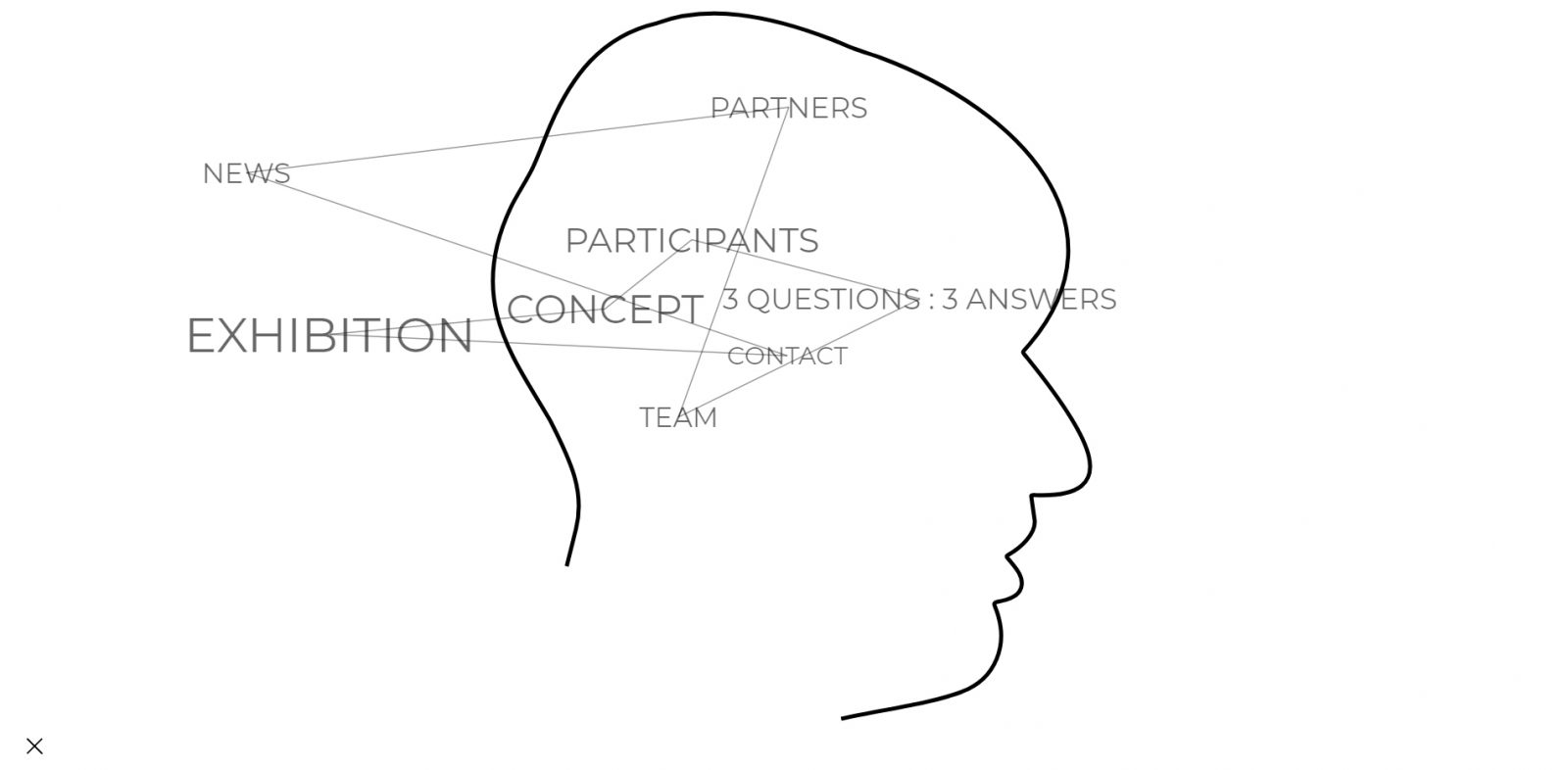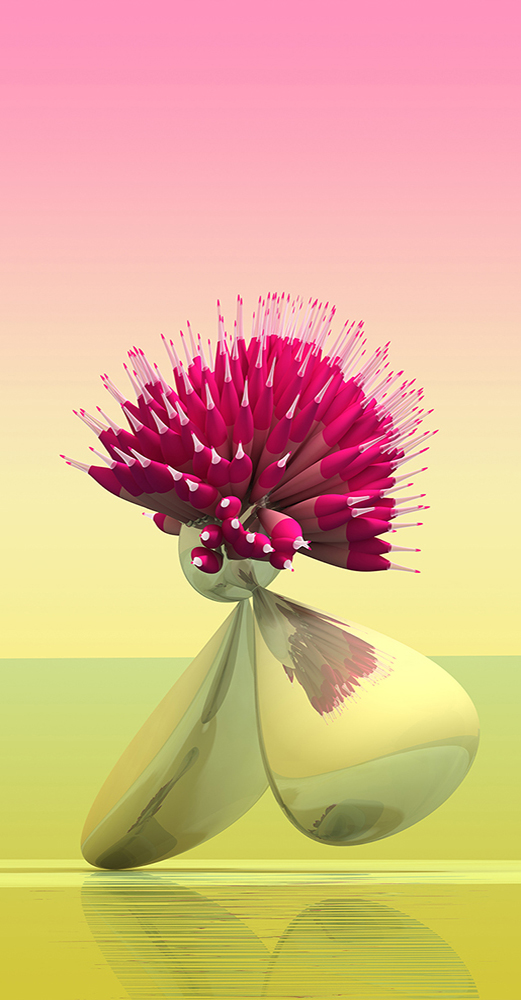
Text by Yury Amosov, senior editor L’officiel Hommes UA
The leading Ukrainian media artist Stepan Ryabchenko has long been known for his virtual worlds. Early May saw the launch of the Strange Time project: the first large-scale international online exhibition in Ukraine that Ryabchenko had created under the aegis of the Art Laboratory art union, in conjunction with the National Center “Ukrainian House.” Contemporary artists from different generations, working in different genres, explore our “strange time” and offer their own appraisals and views of the global events. The project develops organically, always expanding its borders as artists from around the globe upload their works.
We have contacted Stepan to discuss the instruments and practices of virtual art, and to learn more about what’s in store for the new platform.

150 х 300 cm, digital print face-mounted to Diasec
How was the Strange Time conceived?
As I was putting my archive in order on March 22, 2020, I found the work The Pink Fox, created back in 2018. I opened the file and found myself working on it. The palette of this digital heaven has shifted drastically, the image of the protagonist changed shape, and most characters had left the space altogether. Alarm bells rang. This is how my work Hunter came to be, and with it the first thoughts of the future project. I never planned to become a curator, but with the cultural life put on pause during the quarantine, I, being a digital artist, decided to organize an international virtual exhibition, inviting famous artists from around the globe to participate. My goal has been to show the direction of creative efforts these days, and to highlight how the artists from different generations and of different views see and appraise this time. To my delight, my negotiations with each participant left me with the impression that they have all been awaiting this project, working at and focusing on the same topic.

170 × 140 cm, acrylic on canvas
What were your criteria when selecting the exhibition’s participants? What is the narrative of the new platform?
When selecting works, I relied exclusively on my intuition. The first person that I called was my friend, the New York-based artist Alex Yudzon. He was delighted with the initiative. In our conversation about the present situation with COVID-19, he said that we lived in a “strange time.” I instantly realized that it was the perfect title for our project, given that it sounds great in all languages, including Ukrainian, as Oleg Tistol noted: dyvnyi chas [which can denote both strange and miraculous]. Most importantly, the title allows us to address not only the current complex situation but the time we live in as such. Time, that is, had lifted all restrictions, and allowed me, the curator, to engage with a broad range of works and statements. All this has helped me to realize the project in its current shape: innovative in form, engaging in content.

size varies, archival pigment print on paper
The exhibition showcases the works of artists from around the globe, including the new pop surrealist works of the cult American artist Kenny Scharf (a friend of Andy Warhol, Jean-Michel Basquiat and Keith Haring), and conceptual photography of the American artist Alex Yudzon, who creates still lives with flowers that sprout from waste and trash, as well as his new series, in which he transforms hotel room furniture into abstract installations, all with an air of the isolation-ridden quarantine wildness. A photographic series by the Swedish artist Anders Krisar, entitled Flesh Cloud, engages with the transcendental plan and the idea of the illusoriness of the material experience.

152.4 × 121.9 cm, oil, acrylic & diamond dust on linen
Also included were the post-apocalyptic wax sculptures of the Odesa-born Jean Kigel and the wooden paintings of the former Soviet nonconformist and contemporary American artist Lucien Dulfan, a short video and installations by the South African artist Omri Harmelin, ironic works of the Brit Richie Culver, Nik Ramage’s kinetic sculptures and Janessa Clark’s performance, post-conceptual installations of the German artist Hannah Hallermann, the French artist Valentin Abad, the Brazilian Fernando Moletta, the Chilean Alejandro Leonhardt, the abstract works of the Spanish artist Guillermo Mora, and the charming fox of the Belgian artist Jofroi Amaral. Portuguese art is represented by the two futurist video works by Paulo Arraiano, as well as conceptual texts and abstract paintings by Pedro Matos.

7 х 9 х 35 m, plasterboard, wood, metal, paint
The project also features cement installations by Erik Sommer, bronze sculptures and a digital photo collage by David Baskin, different approaches to painting represented by Samuel Jablon, Paul Cooley, David Czupryn, Giulio Malinverni and Jakub Hubálek, and surrealist porcelain by Roxanne Jackson. The Japanese artist Noriko Okaku has created specifically for the project a video collage with a QR code that transports its viewers into a 3D space. In the works selected for the project, the Spanish artist Jesu Moratiel demonstrates the artificial essence of the digital nature, underscoring the tropes of digital deformation, projecting the familiar narratives onto the digital aesthetics. Other representatives of the new media include the German duo lom-of-LaMa, which works in various genres, and the American artist Victoria Keddie. The last artist that I invited to join the project the day before its opening was the master of spatial deconstruction, the German artist Felix Schramm.

160 х 100 cm, digital print and oil on canvas (painting), 160 x 37 cm, stump, metal, concrete, expanded clay (installation)
Ukrainian art is represented both by the famous works that have acquired new meanings within the context of the project, and by never-seen-before new works: Vasiliy Ryabchenko’s expressive painting with elements of digital graphics and an installation, Oleg Tistol’s stereotypes-celebrating post-media painting, Marina Skugareva’s quotidian graphics and Pavlo Kerestey’s disturbing works. The online exhibition also includes Andriy Sagaidakovsky’s instantly recognizable carpet works, Vasyl Tsagolov’s cinematographic hollow paintings, Aljosha’s biofuturist installations, the surrealist collages by Oleksandr Roitburd and the Ukrainian-Danish artist Sergei Sviatchenko, the prophetic paintings by Victor Sydorenko and Mykola Matsenko, Stepan Ryabchenko’s computer viruses and the new work The Hunter, which inspired me to create and launch Strange Time.

200 х 150 cm, oil and acrylic on canvas
What issues did you face when digitizing material objects and forming the exhibition?
Digitization wasn’t an issue since all artists have their own archives. In some cases, they photographed recently completed works and emailed the pictures to me, so there wasn’t a time lag. Sometimes there were delays with writing texts or answering questions, but that came as no surprise to me. I understood that it takes time. Kenny Scharf, who had submitted his texts right before the opening, was a particular joy, but after that, we were a hundred percent ready.
If this ends up becoming a permanent platform for all sorts of projects, what other instruments would you consider incorporating?
At present, the project consists of the exhibition page, where the works and quotes from the artists slide across the screen to be scrutinized as if under a microscope. As new works get uploaded, the space automatically expands to incorporate the new artists. The project also has an artist page with a structured archive of all artists, with succinct and clear descriptions of their artistic career, their works, and their reflections on this strange time, describing how they see it and what they feel. The “3 questions & 3 answers” page features exclusive interviews with the artists in which they answered very important and very personal questions. All these texts are collated on one screen. This allows the visitors to see and compare different opinions, and to get a better sense of the world seen through the lens of the artist’s perspective.
As I worked on the project, I decided to promote and re-launch the Art Laboratory art union, established in 1996 by my father Vasiliy Ryabchenko, within the context of the present time. Its initial goal was to encourage the development of contemporary art in Ukraine and its integration into the global art process. Within the context of the Strange Time project, it has brought together the artists and other creative professions interested in working on their personal and group art projects while engaging with contemporary technologies.
My brother and I are currently putting the finishing touches to the Art Laboratory platform. It will feature a projects page, the archive of the artists working with the organization, a news portal and some innovations that I would like to talk more about when the platform launches. I can say with confidence that I wanted to create the most cutting-edge structure that would develop organically, like a living being.

size varies, digital print
In your opinion, how could the present global pandemic and the objectification of the virus impact the art world of tomorrow?
I hope that the situation has already made an impact, primarily by giving artists an opportunity to consider what they were doing and why, what issues and information they addressed, and what emotions they filled the space with.
digital animation
As you see it, what future trends could arise from this viewers’ freedom and the expanded spectrum of visual instruments/artists’ practices?
I see several possible trajectories of development, not to mention their combinations. I show the big picture and offer a platform both for the newest experiments in art and for traditional forms that acquire new meanings within the context. The viewers can compare and decide what finds a stronger response in them at the moment. The world is interesting precisely in its diversity.

290 х 387 cm, digital print on aluminum
This was your first experience as a curator. Was it hard to become the link between the platform and the artists?
Given that exhibitions of this kind and of this scope were never organized before, I took to work with passion and enthusiasm. Obviously, it was a fantastic experience. Our team has developed an absolutely unique new approach to forming such projects. My brother, Serhii Ryabchenko, developed a creative website that is a work of art in and of itself, and a teaser for the exhibition’s opening with his digital music. Viktoria Kim, the project’s lead coordinator, invested her experience and talent to make sure that we opened on the announced date. My sister, Vira Ryabchenko, helped me to establish contact with the artists, and took on the hard work of translation. Each team member pitched in and contributed their most positive thoughts to make sure that the project became its very best self. Obviously, I’m grateful to the artists who supported my idea and submitted their works and thoughts at such a tight schedule. The trust between artists played an important role. It was a new type of dialogue where we literally finished each other’s sentences.
size varies, digital print
Can we say that digital art has become equal to physical art?
I think that they became equal some five years ago, but today there’s no doubt that digital art is at the forefront. Its innovative ideas, flexibility and the broad spectrum of possible applications are one reason for that. The second reason lies in the fact that there are very many painters, and the art market is oversaturated with paintings. On the other hand, that’s a perfectly natural process. In the first years after I began working with digital art in Ukraine, nobody understood me because nobody had ever done that before: classical canons were very much dominant. Meanwhile, I did what I found interesting, in the way only I knew. At present, after the indiscriminate boom for the magic word “virtualization” began, everybody suddenly rushed to get involved in the digital art and to create portals to promote it without knowing what it was, and, most depressingly, without an understanding of quality. This, I think, is a trap. Rushing after trends is all about grabbing the mirage of illusory success, not life-creation.

150 х 300 cm, digital print, Diasec
Are there any laws that govern the evolution of your reality?
As I develop, so does it. Its protagonists often migrate from one work to the next as my universe brooks no boundaries. I’m now working on the idea of “the digital heaven,” creating fantastical landscapes, nonexistent flowers and new images.
What role does architecture play in this reality?
Its role is foundational. My creative model is based on designing images.
computer animation
Have you ever considered creating animation based on your narratives?
My first experiments with computer animation began literally the moment I started to work on the Computer Viruses series, back in 2008. I work actively with this technology to this day. For example, this year I became a finalist of a big international competition to develop a large-scale work for Tampa International Airport. For this project, I have created what might be my biggest and most technologically sophisticated installation to date. It combines digital animation with the soundtrack written by my brother Serhii Ryabchenko specifically for the purpose. The project was based on the work entitled Electronic Winds, which was exhibited in the central hall of the Ukrainian House National Center at the Media Dependency show. This year, I was invited to represent Ukraine at a contemporary art biennale in South Korea with a computer animation of one of my Virtual Flowers.

computer animation
What, in your opinion, are the main problems of the local institutions and viewers at the moment?
Institutions are often staffed by people who use art works to promote destructive ideas by manipulating notions like “history,” “social justice” or “freedom,” while disregarding alternative views and perspectives on art and life. This produces identical projects geared towards critical analysis and a negative response. These institutions have cultivated groups of artists who create what is in essence commissioned works while believing that they are the most radical and interesting representatives of contemporary art.
During the current coronavirus crisis, representatives of these groups have raised the issue of state support for culture. Indeed, artists have found themselves in a precarious situation. But who received the aid? The very same institutions that always did. And what did the artists not controlled by these institutions receive? Nothing.
Also, there’s talk about the need to establish a contemporary art museum. Who’s talking? Right, those same structures working with those same artists.
I think there should be another way to create a museum. Given that a significant portion of the programmatic works that should represent whole temporal stretches is now in private hands, the new museum should be based on those collections. Obviously, this should be done under the curatorship of a committee representing various perspectives and the collectors themselves. This committee should be in charge of acquisitions, buying works off artists to expand the museum and support the creative professionals. This would ensure that the museum won’t have any lacunae, give the artists confidence that their country needs them, and allow the artists to stay true to themselves without kowtowing to the trends.
As for me, I’m working actively and representing Ukraine on the international level. With a team of like-minded artists, we will keep working under the aegis of the Art Laboratory union, which focuses on experimental approaches based on new technologies, and the integration of Ukrainian art into the global art process. As for the viewers, they won’t have any problems if they trust themselves and their intuition.









